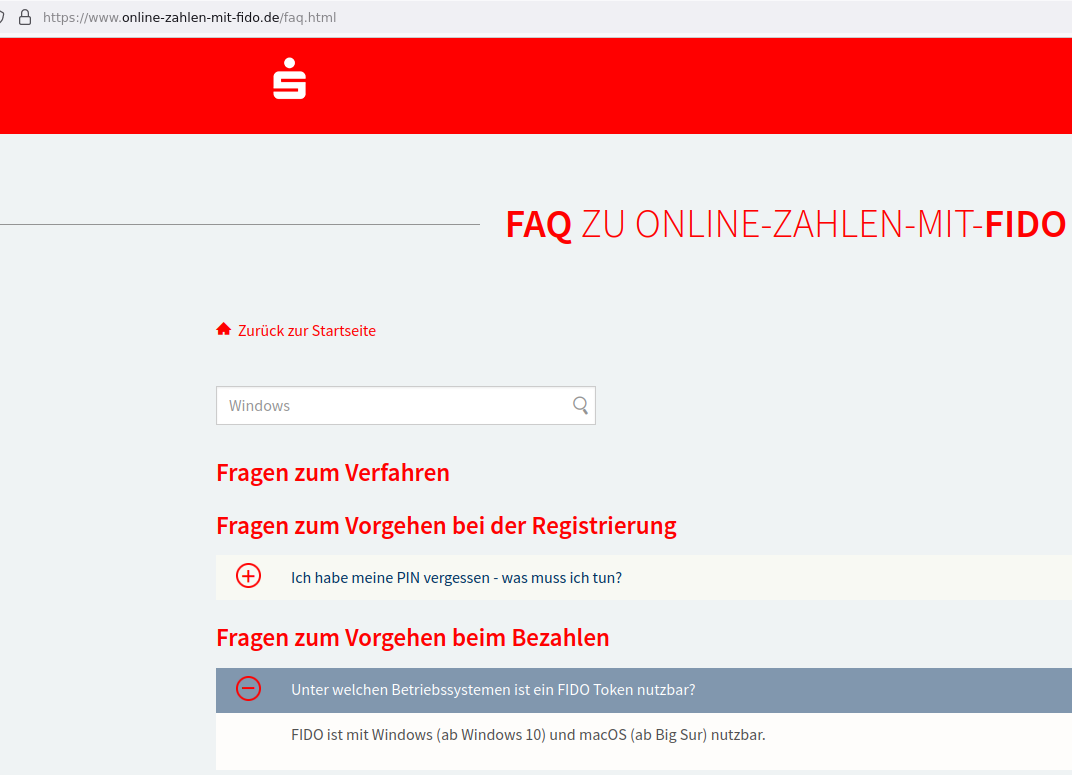Im letzten Jahr hatte ich eine Kreditkarte bei der Sparkasse beantragt — Mastercard war das einzige was im Angebot war, aber gut.
Also beantragt und direkt nach Erhalt einmal benutzt. Schon der zweite Versuch ging in die Hose, da aufgrund von Vorschriften eine Form von MFA zum Einsatz kommen müsse. Ich möge doch bitte die S-ID-Check App der Sparkasse auf meinem Androidgerät installieren. Gesagt getan. Aber huch, die App verweigerte den Dienst, denn mein Androidgerät ist aus Privatsphäre- und Sicherheitsgründen gerootet. Also schnell angefragt bei der Sparkassenberaterin. Ja, es gäbe da noch die Option auf die Nutzung von FIDO2. Ah, super … für mich der erste praktische Anwendungsfall privat, also schnell vom empfohlenen Sparkassen-Shop ein Feitian ePass Fido2 A4B bestellt.
Das war nach ein paar Tagen auch da. Jetzt wurde es schon erstmals bizarr. Bei meiner Sparkasse auf der Webseite gab es keinerlei Dokumentation zum Vorgehen, bei irgendeiner Sparkasse aus Friesland dann hingegen schon. Also hin zu www.online-zahlen-mit-fido.de und Registrierung gestartet.
Und das war es dann, was man als Linuxnutzer zu sehen bekam:

Das Freche daran: mein Browser unterstützt sehr wohl die Nutzung von FIDO2 von Linux aus und die Beschränkung ist wohl ganz einfach eine künstlich geschaffene der PLUSCARD Service-Gesellschaft für Kreditkarten-Processing mbH, bei der man die Registrierung vornehmen soll.
Auf Anfrage kam folgende erhellende Antwort:
Die wichtigste Information zuerst. Der FIDO Token ist in unserem Haus nur mit Windows 10 und macOS (Big Sur) und höher kompatibel.
Alle anderen Betriebssysteme sind von diesem Bezahlverfahren leider ausgeschlossen.
Leider steht da nicht: “Windows 10 und macOS (Big Sur) und besser“, sonst hätte man ja noch diskutieren können 😉
Zu Ihrer zweiten Frage, warum die App nicht auf einem gerooteten Handy genutzt werden kann.
Die Installation der App S-ID-Check kann generell nicht auf gerooteten Geräten durchgeführt werden. Grund hierfür sind die Vorgaben der Bundesanstalt für Finanzdienstleistungsaufsicht (BaFin). Diese besagen, dass verschiedene Sicherheitsvorkehrungen zu treffen sind, wenn der Einkauf als auch die Legitimation der Zahlung über das gleiche Gerät erfolgen.
Die Annahme ich wolle auf dem gleichen Endgerät auf dem ich diese S-ID-App einsetze auch Käufe vornehmen ist zumindest eine gewagte. Wäre mir bis dahin nicht in den Sinn gekommen, aber ist jenes Szenario was verhindert werden muß.
Und weiter:
In diesem Fall muss verhindert werden, dass das Original-Betriebssystem verändert wurde. Dies hat den Ausschluss von gerooteten Geräten zur Folge. Auch bei vergleichbaren Apps am Markt, mit welchen Zahlungen ausgelöst werden können oder auch bei Online-Banking Apps ist diese Konfiguration zu beobachten. Ein Rooting wird in der Regel immer ausgeschlossen.
Das stimmt wohl, auch bei meiner isländischen Bank habe ich bei deren App das Problem. Fazit scheint mir: Rooten == generell böse und unsicher.
Es stellte sich übrigens auch heraus, daß die FAQ der Firma in der Tat die Nutzung von FIDO . Der Wortlaut aus der FAQ (bis zum Tag der Veröffentlichung dieses Beitrags):
FIDO ist mit Windows (ab Windows 10) und macOS (ab Big Sur) nutzbar.

Habe dann einen alternativen Wortlaut vorgeschlagen 😉:
Nutzen Sie ein anderes Betriebssystem als Windows (ab Windows 10) oder macOS (ab Big Sur), verweigern wir Ihnen die Registrierung und Aktivierung Ihres FIDO2-Tokens, sowie dessen Nutzung.
Ebenfalls hatte ich noch geschrieben:
Lassen Sie mich gern wissen, sobald auch Ihre Firma die “Betriebssystem-Apartheid” abgeschafft hat, die ich aufgrund des Plattform-Charakters bei browserbasierten Technologien seit Jahren für Geschichte hielt.
Die Kreditkarte wurde dann nach einmaliger Nutzung seitens der Sparkasse rückabgewickelt. Nächster Versuch wird eventuell dieses Jahr eine Visa-Karte, da die offenbar als Ersatz für die maestro-Karten ab diesem Jahr ausgegeben werden sollen.
Ist schon ein starkes Stück, daß man aufgrund der Nutzung eines bestimmten Betriebssystems einfach ausgeschlossen wird.
// Oliver



